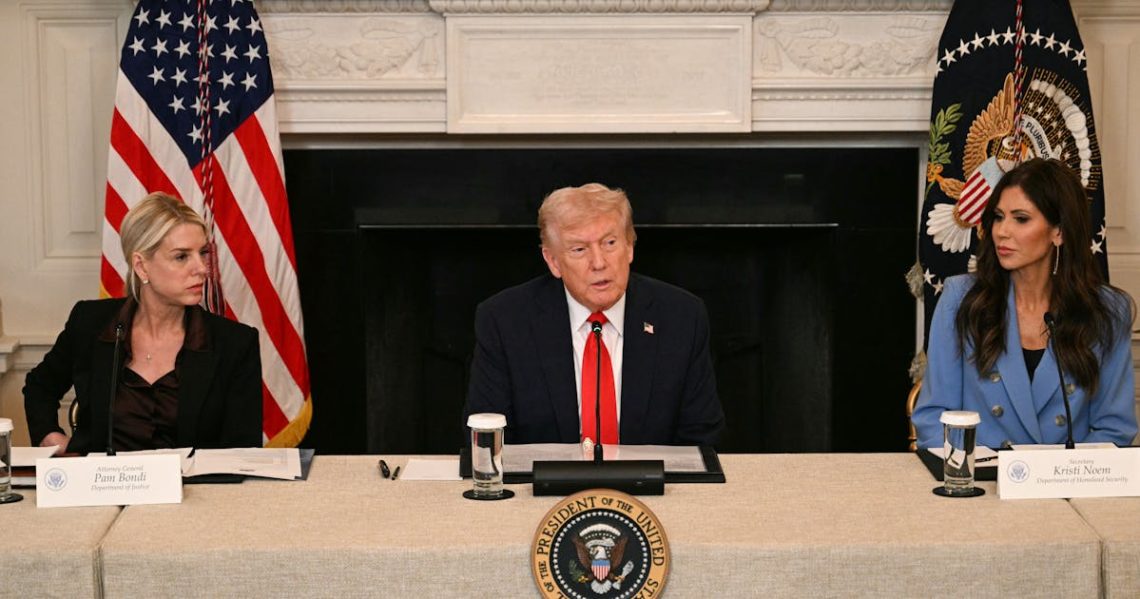In recent days, President Trump and his circle have effectively declared war on “antifa.” They have bestowed a “domestic terrorist” designation upon the anti-fascist movement as a whole. And they have vowed to deploy the full force of the federal government against it—whatever it, in fact, is.
In a roundtable at the White House last week, the president pledged to inflict disproportionate violence on this purported enemy of the people: “We’ll be very threatening to them. Far more than they ever were with us.” Earlier, when he was asked by a reporter, “If someone takes to the streets and says they’re antifa, what happens to them?” he proffered the death penalty.
Speaking of anti-fascists, Secretary of Homeland Security Kristi Noem assured us the government would “root them out and eliminate them,” while likening the movement to MS-13, ISIS, Hezbollah, and Hamas. Attorney General Pam Bondi, for her part, promised to “take them apart,” in her words, “just like we did with cartels” in the Caribbean. (At the aforementioned roundtable, Noem claimed to have “the girlfriend of one of the founders of antifa” in custody, which would surely be news to that founder of antifa, if they existed.)
In the short run, National Security Presidential Memorandum 7, or NSPM-7, and the associated executive orders are sure to lead to the suppression of “anti-fascist,” “anti-American,” “anti-capitalist,” and other speech deemed “treasonous” by the administration, and to the arrest and prosecution of citizens and noncitizens alike who are seen as the “enemy within.”
In the longer run, however, it is likely that this war on anti-fascism will backfire, leading to a heightened profile for the movement and a deepening identification with its ideas and values among the broader populace. In the end, the White House’s strategy, even by its own logic, will prove to be pure folly.
That is not to diminish the very real threat to democracy, human rights, and civil liberties that this latest war on “terrorism” inevitably poses. The hour may be later than we think, and there is no telling what lengths this administration will go to in order to achieve its political objective: to silence its opponents once and for all.
Some Americans will be subjected to secret interrogations, others to public inquisitions. Some will be rounded up in the dead of night, others in the light of day. Paramilitary-style raids will proliferate. “Potential federal crimes” will be investigated under the aegis of the nation’s Joint Terrorism Task Forces. Low-level crimes like trespassing, destruction of property, and “civil disorder” will be treated as “politically motivated terrorist acts” by the Department of Justice.
In the name of the war on antifa, political profiling will expand into every corner of everyday life, including the nonprofit sector, the public university, and private industry, among others. Workers will be driven from the workplace. Intellectuals will be run out of the classroom (or out of the country). Groups aligned with the resistance will lose their tax-exempt status, or worse. The warning signs are here: Sources inside the White House, the Department of Homeland Security, and the DOJ recently leaked a list of at least nine left-leaning organizations that are already in the government’s sights.
All of this will unfold against the backdrop of ongoing military incursions, at the behest of the president, into cities such as Los Angeles, Chicago, Portland, and Washington, D.C., where counterinsurgent tactics are now being tested on their local populations, from the aerial surveillance of suspected anti-fascists to the use of military-grade weaponry against unarmed civilians.
These are dangerous times indeed for those who see fit to exercise their rights to speak freely, to assemble publicly, or to petition for redress of grievances. It is entirely possible that, in the days ahead, resistance movements against the regime will be effectively muzzled, their organizations defunded, their participants criminalized, demobilized, and demoralized.
Yet it can be argued that, despite the perils of the political moment, the war on antifa is ultimately doomed to fail.
For one thing, in branding the movement Public Enemy #1, and in tarring it as a terrorist entity, this administration has massively raised the profile of anti-fascist politics in general, with saturation coverage on a scale not seen since the 2017 Unite the Right rally in Charlottesville, Virginia. While MAGA media has driven much of the coverage, mainstream media has not been far behind.
The Trump administration, in spite of itself, may be helping the words, the images, the ideas, and the values associated with anti-fascism reach millions more Americans than they otherwise would have reached. Some will undoubtedly buy into the master narrative that equates anti-fascism with domestic terrorism. But many more, armed with the ability to do their own research and put off by the administration’s own autocratic and antisocial tactics, will not.
Over time, the ideas and values on which anti-fascism is predicated will likely prove more popular than an increasingly authoritarian presidency. By some measures, they already have, with clear majorities now opposing Trump’s policies on immigration, his attacks on free speech, and his mobilization of the National Guard.
According to a New York Times/Siena poll from the last week of September—the same week Trump signed his executive order on antifa—fully 52 percent of registered voters (including 68 percent of those aged 18 to 29) disapproved of the president’s actions on immigration. A Reuters/Ipsos poll taken last week found 58 percent opposed to his deployment of the military in America’s cities.
Meanwhile, public sympathy with the anti-fascist movement has only grown in recent years. In 2017, polls showed antifa with the support of only 8 percent of respondents (around the same percentage as white nationalists). But by 2024, despite a yearslong campaign to criminalize it, support for the movement had more than doubled.
Antifa represents not a single entity, but a kind of movement of movements, weaving together different strands of political identity with which many Americans have deep affinities, and with which millions have historically demonstrated in solidarity—including the anti-racist, antiwar, queer and feminist, trade unionist, and environmentalist movements of recent years.
In this sense, antifa has become a sort of stand-in for resistance writ large. This is surely one of the reasons the movement has become a favorite bogeyman for the far right. It may also be the reason we are now seeing so many liberals and independents rallying behind its banner—whether via viral memes on social media (such as those featuring Portland’s inflatable antifa animals) or by way of mass marches in the streets (like the one planned for No Kings Day).
The politics of anti-fascism in America, once the province of a militant minority of ultra-left activists, could very well come to be identified, in the near future, with a majoritarian movement against authoritarianism. In this scenario, antifa will be increasingly associated not with fringe groups of street-fighting “supersoldiers” but with a growing base of ordinary Americans who stand opposed to this administration’s all-out assault on their hard-won rights and freedoms.
Some of the most celebrated movements in our history followed a similar path from political repression to public support. In this respect, the anti-fascist movement of the present day is not unlike past waves of political protest, such as the Popular Front against fascism, the civil rights coalition against Jim Crow, or the 99 Percent movement against economic inequality.
The Popular Front against fascism of the 1930s and ’40s started with small groups of socialists during the depths of the Great Depression, then grew into a mass movement that was able (at least for a time) to prevent the ascendancy of an authoritarian regime in the U.S.
The civil rights coalition of the 1950s and ’60s commenced with the actions of a handful of civilly disobedient minorities. It then exploded, amid police attacks and government crackdowns, into a kind of irrepressible force that would transform the racial order in America.
More recently, the 99 Percent movement of the 2010s began with a ragtag band of radicals at Occupy Wall Street who, amid unsuccessful attempts to shut them up, sparked a popular uprising against the wealthiest 1 percent. That uprising continues to have ramifications to this day.
What’s past may be prologue, but the future is unscripted. Which direction this country takes—toward democracy or autocracy, racial justice or white supremacy, gender justice or theocracy—will ultimately be decided not only by the orders of the imperial presidency, but also by the actions (or inaction) of ordinary people in the face of its ever more authoritarian onslaught.
If current trends are any indication, however, the Trump administration’s war on anti-fascism could prove to be its most unpopular war yet—one it has already lost before it has even begun.
The post Trump’s War on Antifa Is Destined to Backfire appeared first on New Republic.




